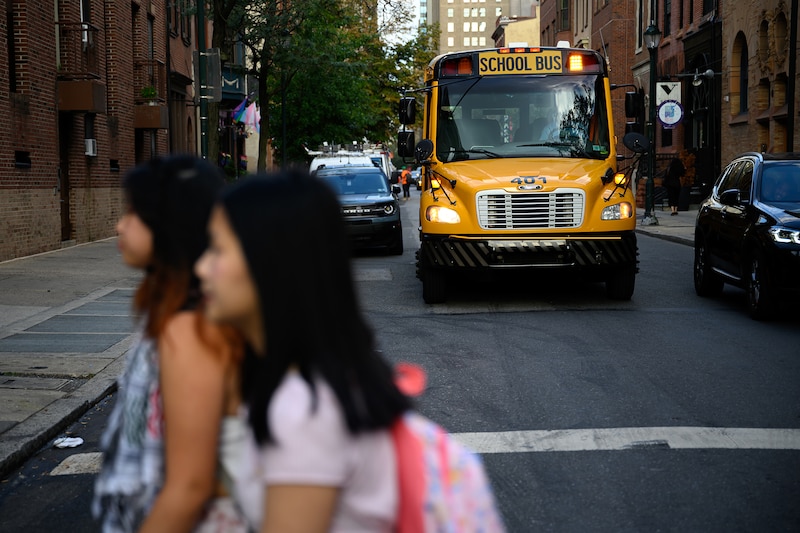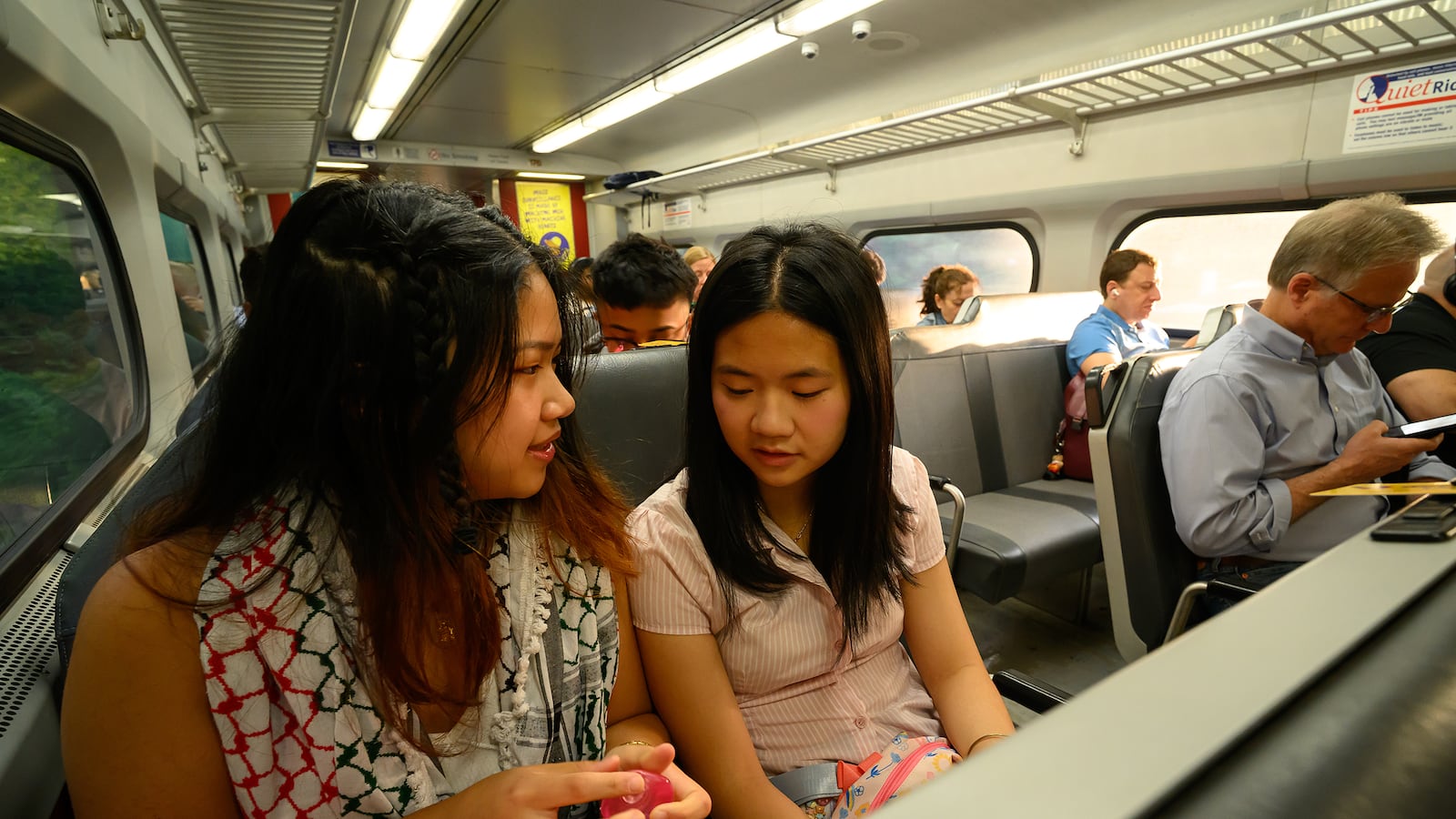Sign up for Chalkbeat Philadelphia’s free newsletter to keep up with the city’s public school system.
Philadelphia high school seniors Aster Chau and Joey Zhou stuck to a routine for the last year to make their more than an hour-long commute to school on SEPTA more bearable.
Each morning, they would find each other on board the train that goes from near their homes far northeast from the city center to Academy at Palumbo nearly 17 miles away in South Philly. “That’s how our friendship bloomed and blossomed,” Chau said.
But in the early morning hours of the first day of school this year, they each braced for a commute that had, overnight, gotten trickier. Their train was about to come less frequently. Their bus would be overcrowded. And the whole commute was about to be less reliable.
“If you’re going to be late, you’re like two hours late, and then there’s just nothing you can do about it,” Zhou said Monday.
This year’s first day of school for Chau, Zhou, and Philadelphia’s nearly 118,000 district students came one day after the region’s public transit system began implementing 20% service cuts due to a funding crisis that state lawmakers have not addressed.
Transit officials have said for weeks that they expected the cuts to leave students and educators who rely on SEPTA with longer and more crowded commutes.
But the school district has not stepped in with an alternative or a plan. Though the district provides bus transportation to elementary school students and students with disabilities, most middle and high school students are expected to take SEPTA if they need to commute to school.
By the end of the school day Monday, Superintendent Tony Watlington said he had already heard from at least one principal that attendance was lower than expected on the first day of school.
At a school board meeting last week, Watlington told parents and students to “Google SEPTA cuts” to find information about routes and to call their principal with any concerns. He also recommended parents apply for the district’s program that could reimburse them for driving eligible children to and from school, although that is mostly reserved for elementary school students.
Deputy Superintendent Oz Hill later sent a message to parents saying that the district understands that the service cuts could present a hardship to staff and families.
“Thousands of students and hundreds of employees ride SEPTA to school and work every day,” Hill said. “As a District, we are hoping that SEPTA receives adequate funding to restore full service.”
But for Philly students and educators, that hope provides little relief. Chau and Zhou said along with college applications and getting through AP classes, they’re preparing to shoulder more transit stress this year too.
“It’s just very frustrating at times,” said Chau. “There’s already a lot going on in our lives, and to have to worry about getting to school on top of that is, like, pushing it.”
Families fear transit cuts will make students late
Chalkbeat asked students and educators across the city about how the SEPTA cuts were affecting them, and heard from dozens of students and parents who shared concerns about missing class, losing extracurricular opportunities, and disincentivizing kids from going to school in the first place.
“I’m honestly worried about how I’m going to be able to get to school,” said Nevaeh Martin, 17, a senior at Central High School.
Usually, Martin’s commute from North Philadelphia takes around 45 minutes — as long as the 54 bus that comes near her house arrives on time. But even before the cuts, the bus was unpredictable. Sometimes, she would have to walk for 30 minutes to get to the train station.
Now, like most bus routes in the city, the 54’s service has been reduced by 20%. Martin said that makes her worried that the 6:50 a.m. bus she usually catches might not show up at all.
“If that bus doesn’t come, or a bus earlier doesn’t come, then basically I’ll be late to school,” she said.

Northeast Philadelphia, where there is limited public transportation to begin with, has been hit hardest by the transit cuts. Many students in those neighborhoods who take SEPTA to school will have to walk further, wait longer, or find an alternative way to get to school.
Ella Nguyen, 17, who attends Northeast High School, said she usually takes the bus that goes near her house to school. But now, she’s working on getting her driver’s license so she can borrow one of her family member’s cars to get to school.
“I really didn’t want to drive, because I didn’t see a purpose to it since I relied on SEPTA,” Nguyen said. “But now it’s like, I really hate taking crowded buses. I’m like, wow, I should really learn how to drive for this.”
Still, for many students, there’s no alternative available.
Standing on the platform at Philmont regional rail stop on Monday morning, Chau waved hello to other students readying for their commute to the first day of school. Though many, including Chau, get a ride to the station, they must make their own way into the city for school.

When the train pulled into the station just before 7 a.m., it was already packed with commuters. Students found empty seats in the quiet car, where their chatter was quickly shushed by adults riding the train to work.
Zhou got on at the next stop and slid in next to Chau. They whispered and used their phones for the rest of the 30-minute ride to the Jefferson train station. There, they tried to catch the 45 bus, but it pulled away right as they got out onto the street. That meant they had to walk the final mile to school.
“We dread it,” said Zhou, adding that she got dinged for being late countless times last year because the bus would pass them.
But Chau said she doesn’t mind the walk, especially compared with trying to squeeze onto a crowded bus. And this way, the teenagers get to hang out a bit longer before the school day begins.
Teachers say the district has not provided guidance
Though the SEPTA cuts have loomed for weeks, several teachers Chalkbeat spoke with said they worried the district had no thorough plan in place to support students and educators navigate transportation delays on the first day of school.
“I received no communication as a teacher from the district about the potential of SEPTA cuts and how that can affect attendance and tardiness,” said Cady Zuvich, a second grade teacher at Ziegler Elementary School.
Zuvich said she worried for students she knew who had graduated and were starting middle school this year, many of whom would have to consistently take SEPTA to school for the first time. Some of those students may expect a bus to show up that was part of the cuts, leaving them waiting and confused, she said.
Zuvich said she had concerns about her own commute too. Like many Philadelphia teachers, she takes SEPTA to get to work. But delays have already made her late in the past. She said the further cuts would likely make those problems even more frequent.
Thomas Quinn, who teaches civics at Central High School, said he worries the transit cuts will exacerbate inequities in the city, and make it even more difficult for families who live in underserved neighborhoods to get to school.
He said he plans to use SEPTA’s transit funding crisis as a teaching moment, to explain to students how government action — and inaction — affects their everyday lives.
“It’s something we just need to make sure we’re speaking up about, helping students understand the stakes and how this came to be,” said Quinn. “And then make sure they vote in November.”
Christina Puntel, a Spanish teacher at Walter B. Saul High School, said she wished school officials had been more proactive in providing resources and alternatives to families who rely on SEPTA.
“I think if the district spent a minute listening to parents and children, then we would have at least some tenable way through this,” Puntel said.
As for Chau and Zhou, the students hope their teachers will be understanding this year when SEPTA makes them late. But more than that, they hope the transit system will improve and get the funding it needs to reverse the cuts.
Next week, when the full extent of the first round of SEPTA cuts kick in and regional rail schedules change, the only train that will get them to school on time will leave at 6:24 a.m. — half an hour earlier than their already-early morning commute.
“I just feel like SEPTA is so important to everybody in Philly, but especially for students,” said Zhou. “It’s just going to make everything harder.”
This story has been updated with additional information from Superintendent Tony Watlington.
Rebecca Redelmeier is a reporter at Chalkbeat Philadelphia. She writes about public schools, early childhood education, and issues that impact students, families, and educators across Philadelphia. Contact Rebecca at rredelmeier@chalkbeat.org.

